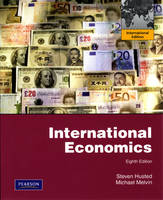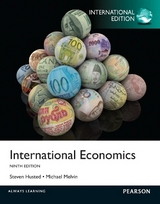
International Economics
Pearson (Verlag)
978-0-321-61490-2 (ISBN)
- Titel erscheint in neuer Auflage
- Artikel merken
Capture students’ attention with the issues and real data of today’s most recent policy controversies.
International Economics is an accessible, comprehensive and relevant guide for studying international economics. Using real data and issues that motivate theoretical discussions, this text captures students’ attention and equips them with a practical understanding of major policy questions.
In the eighth edition, there have been extensive updates to data sets and figures, and coverage on a number of current issues has been expanded. In addition, more examples and real-world applications have been provided to improve students’ comprehension and deepen their analysis of challenging theories and applications.
Steven Husted Professor of Economics, University of Pittsburgh. Ph.D., Michigan State University. Past experience includes Senior Staff Economist: Council of Economic Advisers; Visiting Scholar: International Monetary Fund; and Visiting Professor: Department of Economics and Research School of the Social Sciences, Australian National University; and Departments of Economics, the University of Glasgow and the University of Strathclyde. Professor Husted’s research interests are in international trade policy and international finance, and he has published scholarly articles in Journal of Political Economy, Review of Economics and Statistics, and other major journals. Michael Melvin Head of Currency Research, Barclays Global Investers and Co-editor, Journal of International Money and Finance. Former Professor of Economics and Dean’s Council Distinguished Scholar, Arizona State University. Ph.D., UCLA. Past experience includes Visiting Scholar: Federal Reserve Board and International Monetary Fund; and Visiting Professor: Kellogg Graduate School of Management, Northwestern University; Anderson Graduate School of Management, UCLA; Department of Economics, U.C. San Diego, and Pacific Asian Management Institute, University of Hawaii. Professor Melvin’s research interests are in international finance, and he has published scholarly articles in American Economic Review, Journal of Finance, and other major journals.
Chapter 1: An Introduction to International Trade
Introduction
Characteristics of National Economies
Economic Growth
International Trade
The Direction of International Trade
What Goods Do Countries Trade?
Summary
Exercises
Chapter 2:Tools of Analysis for International Trade Models
Introduction
Some Methodological Preliminaries
The Basic Model: Assumptions
The Basic Model: Solutions
Measuring National Welfare
National Supply and Demand
Summary
Exercises
Appendix 2.1: Derivation of National Supply and Demand Curves
Chapter 3: The Classical Model of International Trade
Introduction
Absolute Advantage as a Basis for Trade: Adam Smith’s Model
Comparative Advantage as a Basis for Trade: David Ricardo’s Model.
The General Equilibrium Solution of the Classical Model
The Gains from International Trade
The Relationship Between Trade and Wages
An Evaluation of the Classical Model
Summary
Exercises
Appendix 3.1
Appendix 3.2
Chapter 4: Budgets and Balance Sheets — Your Personal Financial Statements
Introduction
The HO Model: Basic Assumptions
The HO Theorem
Equilibrium in the HO Model
Some New HO Theorems
Some Final Observations.
Summary
Exercises
Appendix 4.1
Appendix 4.2
Chapter 5: Tests of Trade Models: The Leontief Paradox and Its Aftermath
Introduction
Tests of the Classical Model
Tests of the HO Model
Attempted Reconciliations of Leontief’s Findings
Other Tests of the HO Model
Summary
Exercises
Chapter 6: Tariffs
Introduction
The Gains from Free Trade
Tariffs: An Introduction
Tariffs: An Economic Analysis
The Gains From Free Trade: One More Time
The Welfare Cost of Tariffs
Tariffs: Some Extensions
Export Tariff
The Optimal Tariff
How High are Tariffs
Summary
Exercises
References
Chapter 7: Nontariff Barriers and Arguments for Protection
Introduction
Quotas
The Welfare Effects of Quotas
The Equivalence of Nonequivalence of Tarrifs and Quotas
Other Nontariff Barriers
Customs Valuation Practices
Government Procurement Policies
Technical Barriers to Trade
Health and Safety Standards
Failure to Protect Intellectual Property Rights
Export Subsidies
Arguments for Protection
Invalid Arguments
Patriotism
Employment
Fallacy of Composition
Fair Play for Domestic Industry
Preservation of the Home Market
Valid Arguments
Government Revenue
Income Redistribution
Noneconomic Goals
Infant Industry Protection
Domestic Distortions
Protecting the Environment
Strategic Trade Policies
Summary
Exercises
References
Chapter 8: Commercial Policy: History and Practice
Introduction
History of U.S. Commercial Policy
The Uruguay Round and the Creation of the WTO
The DOHA Round
The Conduct of U.S. Commercial Policy
Unfair Foreign Practices: Section 301
The Escape Clause: Section 201
Other Measures
Comparisons with Policies in Other Countries
Summary
Exercises
References
Chapter 9: Preferential Trade Arrangements
Introduction
Preferential Trade Arrangements: Economic Analysis
North American Free Trade Agreement
Other U.S. Free Trade Area Agreements
European Union
The EU Government
The Single Market Initiative
Regionalism Versus Multilateralism
Summary
Exercises
References
Chapter 10: International Trade and Economic Growth
Introduction
Trade and Development
Primary-Export-Led Development Policies
Import-Substitution Development Policies
Outward-Looking Development Policies
Trade and Growth
Trade and Growth: Some Additional Comments
Growth, Prices, and Welfare
International Flows of Factors
Labor
Capital
Economic Analysis
Summary
Exercises
References
Chapter 11: An Introduction to International Finance
Introduction
The Balance of Payments
Exchange Rates
Prices and Exchange Rates
Interest Rates and Exchange Rates
Additional Major Topics
Summary
Exercises
References
Chapter 12: The Balance of Payments
Introduction
Current Account
Financing the Current Account: The Financial Account
National Saving, Investment, and the Current Account
Additional Summary Measures
Transactions Classification
Balance-of-Payments Equilibrium and Adjustment
Summary
Exercises
References
Chapter 13: The Foreign-Exchange Market
Introduction
Spot Rates
Arbitrage
Forward Rates
Swaps
Foreign-Currency Options
Exchange Rate Supply and Demand and Central-Bank Intervention
Black Markets and Parallel Markets
Summary
Exercises
References
Chapter 14: Prices and Exchange Rates: Purchasing Power Parity
Introduction
Absolute Purchasing Power Parity
Relative Purchasing Power Parity
Time, Inflation, and PPP
Deviations from PPP
“Overvalued” and “Undervalued” Currencies
Real Exchange Rates
Summary
Exercises
References
Chapter 15: Exchange Rates, Interest Rates, and Interest Parity
Introduction
Interest Parity
Interest Rates and Inflation
Exchange Rates, Interest Rates, and Inflation
Expected Exchange Rates and the Term Structure of Interest Rates
Summary
Exercises
References
Chapter 16: Foreign-Exchange Risk, Forecasting, and International Investment
Introduction
Types of Foreign-Exchange Risk
Foreign-Exchange risk Premium
Market Efficiency
Foreign-Exchange Forecasting
International Investment and Portfolio Diversification
Direct Foreign Investment
Capital Flight
Capital Inflow Issues
International Lending and Crises
Summary
Exercises
References
Chapter 17: Basic Theories of the Balance of Payments
Introduction
The Elasticities Approach to the Balance of Trade
Elasticities and J Curves
The Currency-Contract Period/
The Pass-Through Period
Section IV — The U.S. balance of trade decreases
Section III — The U.S. balance of trade is constant
Section II — Balance of trade may increase or decrease
Section I — Balance of trade increases
The Evidence from Devaluations
The Absorption Approach
The Monetary Approach to the Balance of Payments
Summary
Exercises
References
Chapter 18: Exchange Rate Theories
Introduction
The Asset Approach
The Monetary Approach
The Portfolio-Balance Approach
Sterilization
Currency Substitution
The Role of News
Foreign-Exchange Market Microstructure
Exchange Rates and the Trade Balance
Overshooting Exchange Rates
Summary
Exercises
References
Chapter 19: Alternative International Monetary Standards
Introduction
The Gold Standard: 1880-1914
The Interwar Period: 1918-1939
The Gold Exchange Standard: 1944-1970
The Transition Years: 1971-1973
Floating Exchange Rates: Since 1973
The Choice of an Exchange Rate System
Optimum Currency Areas
The European Monetary System and the Euro
Target Zones
Currency Boards
International Reserve Currencies
Multiple Exchange Rates
Summary
Exercises
References
Chapter 20: International Banking, Debt, and Risk
Introduction
The Origins of Offshore Banking
International Banking Facilities
Offshore Banking Practices
International Debt
IMF Conditionality
The Role of Corruption
Country-Risk Analysis
Summary
Exercises
References
Chapter 21: Open-Economy Macroeconomic Policy and Adjustment
Introduction
Internal and External Macroeconomic Equilibrium
The IS Curve
The LM Curve
The BP Curve
Equilibrium
Monetary Policy under Fixed Exchange Rates
Fiscal Policy under Fixed Exchange Rates
Monetary Policy under Floating Exchange Rates
Fiscal Policy under Floating Exchange Rates
The New Open-Economy Macroeconomics
International Policy Coordination
Global Financial Crisis and Macroeconomic Effects
The Open-Economy Multiplier
Summary
Exercises
References
| Erscheint lt. Verlag | 16.7.2009 |
|---|---|
| Sprache | englisch |
| Maße | 231 x 187 mm |
| Gewicht | 792 g |
| Themenwelt | Wirtschaft ► Volkswirtschaftslehre ► Makroökonomie |
| ISBN-10 | 0-321-61490-9 / 0321614909 |
| ISBN-13 | 978-0-321-61490-2 / 9780321614902 |
| Zustand | Neuware |
| Haben Sie eine Frage zum Produkt? |
aus dem Bereich



